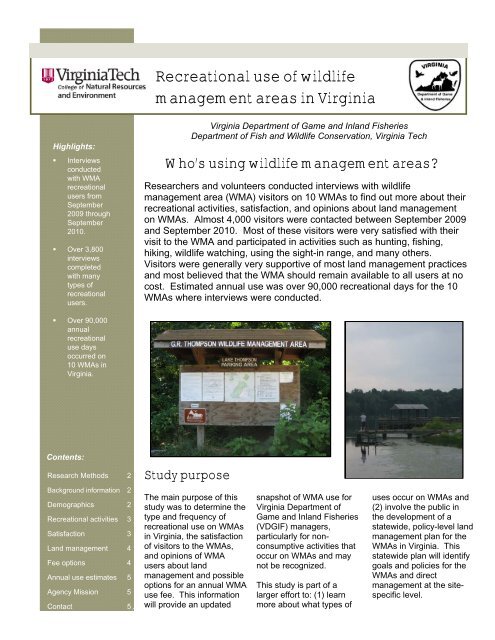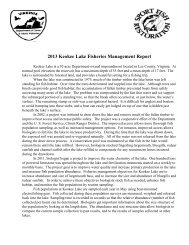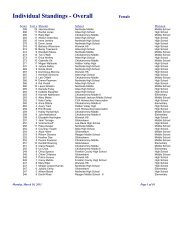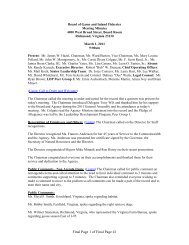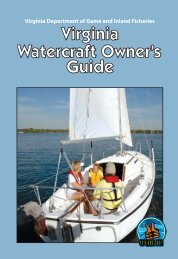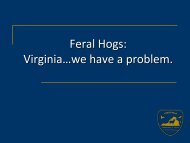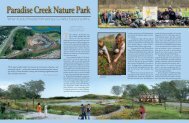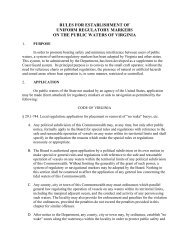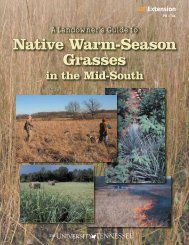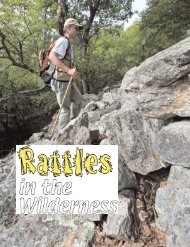Recreational use of wildlife management areas in Virginia
Recreational use of wildlife management areas in Virginia
Recreational use of wildlife management areas in Virginia
Create successful ePaper yourself
Turn your PDF publications into a flip-book with our unique Google optimized e-Paper software.
<strong>Recreational</strong> <strong>use</strong> <strong>of</strong> <strong>wildlife</strong><br />
<strong>management</strong> <strong>areas</strong> <strong>in</strong> Virg<strong>in</strong>ia<br />
Highlights:<br />
• Interviews<br />
conducted<br />
with WMA<br />
recreational<br />
<strong>use</strong>rs from<br />
September<br />
2009 through<br />
September<br />
2010.<br />
• Over 3,800<br />
<strong>in</strong>terviews<br />
completed<br />
with many<br />
types <strong>of</strong><br />
recreational<br />
<strong>use</strong>rs.<br />
Virg<strong>in</strong>ia Department <strong>of</strong> Game and Inland Fisheries<br />
Department <strong>of</strong> Fish and Wildlife Conservation, Virg<strong>in</strong>ia Tech<br />
Who’s us<strong>in</strong>g <strong>wildlife</strong> <strong>management</strong> <strong>areas</strong><br />
Researchers and volunteers conducted <strong>in</strong>terviews with <strong>wildlife</strong><br />
<strong>management</strong> area (WMA) visitors on 10 WMAs to f<strong>in</strong>d out more about their<br />
recreational activities, satisfaction, and op<strong>in</strong>ions about land <strong>management</strong><br />
on WMAs. Almost 4,000 visitors were contacted between September 2009<br />
and September 2010. Most <strong>of</strong> these visitors were very satisfied with their<br />
visit to the WMA and participated <strong>in</strong> activities such as hunt<strong>in</strong>g, fish<strong>in</strong>g,<br />
hik<strong>in</strong>g, <strong>wildlife</strong> watch<strong>in</strong>g, us<strong>in</strong>g the sight-<strong>in</strong> range, and many others.<br />
Visitors were generally very supportive <strong>of</strong> most land <strong>management</strong> practices<br />
and most believed that the WMA should rema<strong>in</strong> available to all <strong>use</strong>rs at no<br />
cost. Estimated annual <strong>use</strong> was over 90,000 recreational days for the 10<br />
WMAs where <strong>in</strong>terviews were conducted.<br />
• Over 90,000<br />
annual<br />
recreational<br />
<strong>use</strong> days<br />
occurred on<br />
10 WMAs <strong>in</strong><br />
Virg<strong>in</strong>ia.<br />
Contents:<br />
Research Methods 2<br />
Study purpose<br />
Background <strong>in</strong>formation 2<br />
Demographics 2<br />
<strong>Recreational</strong> activities 3<br />
Satisfaction 3<br />
Land <strong>management</strong> 4<br />
Fee options 4<br />
Annual <strong>use</strong> estimates 5<br />
Agency Mission 5<br />
Contact 5<br />
The ma<strong>in</strong> purpose <strong>of</strong> this<br />
study was to determ<strong>in</strong>e the<br />
type and frequency <strong>of</strong><br />
recreational <strong>use</strong> on WMAs<br />
<strong>in</strong> Virg<strong>in</strong>ia, the satisfaction<br />
<strong>of</strong> visitors to the WMAs,<br />
and op<strong>in</strong>ions <strong>of</strong> WMA<br />
<strong>use</strong>rs about land<br />
<strong>management</strong> and possible<br />
options for an annual WMA<br />
<strong>use</strong> fee. This <strong>in</strong>formation<br />
will provide an updated<br />
snapshot <strong>of</strong> WMA <strong>use</strong> for<br />
Virg<strong>in</strong>ia Department <strong>of</strong><br />
Game and Inland Fisheries<br />
(VDGIF) managers,<br />
particularly for nonconsumptive<br />
activities that<br />
occur on WMAs and may<br />
not be recognized.<br />
This study is part <strong>of</strong> a<br />
larger effort to: (1) learn<br />
more about what types <strong>of</strong><br />
<strong>use</strong>s occur on WMAs and<br />
(2) <strong>in</strong>volve the public <strong>in</strong><br />
the development <strong>of</strong> a<br />
statewide, policy-level land<br />
<strong>management</strong> plan for the<br />
WMAs <strong>in</strong> Virg<strong>in</strong>ia. This<br />
statewide plan will identify<br />
goals and policies for the<br />
WMAs and direct<br />
<strong>management</strong> at the sitespecific<br />
level.
Background <strong>in</strong>formation<br />
Wildlife <strong>management</strong> <strong>areas</strong> Page 2 <strong>of</strong> 5<br />
Most state <strong>wildlife</strong><br />
agencies own and<br />
manage <strong>wildlife</strong><br />
<strong>management</strong> <strong>areas</strong><br />
(WMAs) primarily to<br />
ma<strong>in</strong>ta<strong>in</strong> and enhance<br />
<strong>wildlife</strong> habitat and provide<br />
public hunt<strong>in</strong>g and fish<strong>in</strong>g<br />
opportunities. These<br />
lands provide opportunity<br />
for both traditional <strong>wildlife</strong><br />
recreation as well as other<br />
forms <strong>of</strong> outdoor<br />
recreation (e.g., hik<strong>in</strong>g,<br />
horseback rid<strong>in</strong>g),<br />
provided recreational <strong>use</strong>s<br />
do not conflict with the<br />
ma<strong>in</strong> goal <strong>of</strong> manag<strong>in</strong>g<br />
<strong>wildlife</strong> habitat.<br />
Participation <strong>in</strong> nonconsumptive<br />
outdoor<br />
recreation is perceived to<br />
be <strong>in</strong>creas<strong>in</strong>g. Although<br />
decl<strong>in</strong><strong>in</strong>g participation <strong>in</strong><br />
traditional <strong>wildlife</strong><br />
recreation is well<br />
documented, little<br />
<strong>in</strong>formation exists<br />
regard<strong>in</strong>g nonconsumptive<br />
stakeholders<br />
who recreate on public<br />
hunt<strong>in</strong>g and fish<strong>in</strong>g lands.<br />
Hunters and anglers<br />
support the <strong>management</strong><br />
and upkeep <strong>of</strong> WMAs<br />
through license fees and<br />
excise taxes on hunt<strong>in</strong>g<br />
and fish<strong>in</strong>g equipment, but<br />
other non-licensed <strong>use</strong>rs<br />
generally do not contribute<br />
to the operational costs <strong>of</strong><br />
WMAs.<br />
Research Methods<br />
Interviews were<br />
conducted on 10 WMAs<br />
throughout the<br />
Commonwealth selected<br />
by VDGIF <strong>in</strong>clud<strong>in</strong>g:<br />
Amelia, Big Survey,<br />
Cavalier, Chickahom<strong>in</strong>y,<br />
Cl<strong>in</strong>ch Mounta<strong>in</strong>, Dick<br />
Cross, Goshen, Little<br />
North Mounta<strong>in</strong>, Phelps,<br />
and Thompson. Virg<strong>in</strong>ia<br />
Tech staff and students,<br />
and VDGIF staff and<br />
Complementary Work<br />
Force volunteers<br />
conducted brief 3-5<br />
m<strong>in</strong>ute <strong>in</strong>terviews with<br />
WMA visitors from<br />
September 5, 2009<br />
through September 3,<br />
2010, usually as they<br />
were leav<strong>in</strong>g the WMA.<br />
Visitors were asked about<br />
their recreational activity,<br />
frequency <strong>of</strong> visits to the<br />
WMA, satisfaction with<br />
their visit, and their<br />
op<strong>in</strong>ions about land<br />
<strong>management</strong> and<br />
potential annual fee<br />
options for the WMAs.<br />
Sampl<strong>in</strong>g days at each<br />
WMA were selected at<br />
random while account<strong>in</strong>g<br />
for weekdays and weekend<br />
day <strong>use</strong>, as well as<br />
seasons and hunt<strong>in</strong>g<br />
seasons. Special open<strong>in</strong>g<br />
days or target days were<br />
surveyed <strong>in</strong> addition to<br />
regular days s<strong>in</strong>ce <strong>use</strong> was<br />
expected to be much higher<br />
on those days compared to<br />
regular survey days.<br />
Demographics<br />
Female<br />
6%<br />
The majority <strong>of</strong><br />
respondents were male<br />
(94%). Over 25% <strong>of</strong><br />
respondents were<br />
between 40 and 49 years<br />
<strong>of</strong> age, mak<strong>in</strong>g up the<br />
largest proportion <strong>of</strong><br />
WMA <strong>use</strong>rs.<br />
Male<br />
94%<br />
The average group size<br />
at all 10 WMAs was<br />
around 2 <strong>in</strong>dividuals.<br />
WMA field survey respondents
Page 3 <strong>of</strong> 5<br />
Wildlife <strong>management</strong> <strong>areas</strong><br />
<strong>Recreational</strong> activities<br />
The majority <strong>of</strong><br />
participants (84%) held a<br />
valid Virg<strong>in</strong>ia hunt<strong>in</strong>g<br />
and/or fish<strong>in</strong>g license,<br />
rang<strong>in</strong>g from a low <strong>of</strong> 56%<br />
<strong>of</strong> respondents at<br />
Thompson WMA <strong>in</strong><br />
Northern Virg<strong>in</strong>ia to a high<br />
<strong>of</strong> 95% at Cavalier <strong>in</strong> the<br />
southeast and Little North<br />
Mounta<strong>in</strong> <strong>in</strong> the west.<br />
<strong>Recreational</strong> <strong>use</strong> varied<br />
by WMA based on season<br />
and recreational<br />
opportunities available.<br />
Hunt<strong>in</strong>g or fish<strong>in</strong>g<br />
license<br />
16% no<br />
84% yes<br />
Hunt<strong>in</strong>g was the most<br />
frequently reported activity<br />
dur<strong>in</strong>g open seasons, with<br />
54% <strong>of</strong> survey<br />
respondents (2,062<br />
<strong>in</strong>dividuals) report<strong>in</strong>g<br />
hunt<strong>in</strong>g participation<br />
dur<strong>in</strong>g their visit. Fish<strong>in</strong>g<br />
(22%), us<strong>in</strong>g the sight-<strong>in</strong><br />
range (13%), and hik<strong>in</strong>g or<br />
walk<strong>in</strong>g for purposes other<br />
than hunt<strong>in</strong>g, fish<strong>in</strong>g, and<br />
<strong>wildlife</strong> watch<strong>in</strong>g (13%)<br />
also were frequently<br />
reported activities among<br />
the WMAs sampled.<br />
Other activities <strong>in</strong>clud<strong>in</strong>g<br />
camp<strong>in</strong>g, <strong>wildlife</strong><br />
watch<strong>in</strong>g, boat<strong>in</strong>g, and<br />
horseback rid<strong>in</strong>g were<br />
fairly common. Some<br />
activities occurred on all<br />
10 WMAs surveyed (e.g.,<br />
hunt<strong>in</strong>g), whereas other<br />
<strong>use</strong>s (e.g., wildflower<br />
watch<strong>in</strong>g) were<br />
concentrated at a few or a<br />
s<strong>in</strong>gle WMA where such<br />
recreational opportunities<br />
existed.<br />
Little North Mounta<strong>in</strong><br />
Satisfaction rat<strong>in</strong>gs<br />
Goshen<br />
Thompson<br />
Chickahom<strong>in</strong>y<br />
Amelia<br />
Phelps<br />
Cl<strong>in</strong>ch Mounta<strong>in</strong><br />
Dick Cross<br />
Big Survey<br />
Cavalier<br />
4.5<br />
5.6<br />
5.5<br />
5.4<br />
5.8<br />
5.8<br />
5.7<br />
5.7<br />
6.2<br />
6.0<br />
1 2 3 4 5 6 7<br />
Very<br />
Neutral<br />
Very<br />
dissatisfied<br />
satisfied<br />
Satisfaction<br />
Overall, most WMA<br />
<strong>use</strong>rs (82%) reported<br />
that they were satisfied<br />
to very satisfied with their<br />
visit to the WMA.<br />
Average rat<strong>in</strong>gs ranged<br />
from 4.5 at Little North<br />
Mounta<strong>in</strong> to 6.2 at<br />
Goshen. In most cases,<br />
non-license holders rated<br />
their satisfaction slightly<br />
higher than license<br />
holders.<br />
Only 9% <strong>of</strong> WMA <strong>use</strong>rs<br />
expressed dissatisfaction<br />
with their visits. The<br />
most common reasons<br />
for dissatisfaction were:<br />
hunt<strong>in</strong>g or fish<strong>in</strong>g trip<br />
was not successful, did<br />
not see any game, or the<br />
weather was poor. In<br />
some cases, visitors<br />
reported a conflict with<br />
another recreational <strong>use</strong>r<br />
group or overcrowd<strong>in</strong>g<br />
on open<strong>in</strong>g days <strong>of</strong><br />
hunt<strong>in</strong>g seasons as<br />
reasons for<br />
dissatisfaction.
Land <strong>use</strong> and <strong>management</strong><br />
Wildlife <strong>management</strong> <strong>areas</strong> Page 4 <strong>of</strong> 5<br />
Overall, WMA <strong>use</strong>rs were<br />
very supportive <strong>of</strong> logg<strong>in</strong>g<br />
(73%), prescribed burn<strong>in</strong>g<br />
(77%), mechanical<br />
techniques for manag<strong>in</strong>g<br />
vegetation (87%) and<br />
plant<strong>in</strong>g food plots for<br />
<strong>wildlife</strong> (92%). However,<br />
many WMA <strong>use</strong>rs<br />
opposed the <strong>use</strong> <strong>of</strong><br />
herbicides to manage<br />
vegetation (46%).<br />
Hunt<strong>in</strong>g and fish<strong>in</strong>g license<br />
holders were slightly more<br />
supportive than nonlicense<br />
holders <strong>of</strong> the land<br />
<strong>management</strong> practices,<br />
although non-license<br />
holders still were<br />
supportive <strong>of</strong> most land<br />
<strong>management</strong> techniques,<br />
Annual fee options<br />
Virg<strong>in</strong>ia’s WMAs usually<br />
were acquired (at least <strong>in</strong><br />
part) with funds<br />
generated by the sale <strong>of</strong><br />
hunt<strong>in</strong>g and fish<strong>in</strong>g<br />
licenses and from excise<br />
taxes on the purchase <strong>of</strong><br />
outdoor recreational<br />
equipment. Seventeen<br />
percent <strong>of</strong> all<br />
respondents believed all<br />
<strong>use</strong>rs <strong>of</strong> Virg<strong>in</strong>ia’s<br />
WMAs, <strong>in</strong>clud<strong>in</strong>g hunt<strong>in</strong>g<br />
and fish<strong>in</strong>g license<br />
holders, should pay an<br />
annual fee to <strong>use</strong> WMAs,<br />
32% believed only those<br />
who do not hold a valid<br />
Virg<strong>in</strong>ia hunt<strong>in</strong>g and/or<br />
fish<strong>in</strong>g license should<br />
have to pay an annual<br />
fee, and 51% believed<br />
Virg<strong>in</strong>ia’s WMAs should<br />
but to a lesser degree.<br />
However, <strong>use</strong> <strong>of</strong><br />
herbicides was opposed<br />
by many hunt<strong>in</strong>g and<br />
fish<strong>in</strong>g license holders<br />
(45%) and non-license<br />
holders (53%).<br />
rema<strong>in</strong> available to<br />
anyone who wants to<br />
<strong>use</strong> them at no cost.<br />
We asked participants<br />
a second question, <strong>in</strong><br />
which we provided a<br />
randomly selected<br />
hypothetical annual fee<br />
rang<strong>in</strong>g from $5-25.<br />
Over 90% <strong>of</strong> both<br />
license holders and<br />
non-license holders<br />
were will<strong>in</strong>g to pay an<br />
annual fee <strong>of</strong> $5, which<br />
decl<strong>in</strong>ed to just over<br />
60% as the annual fee<br />
<strong>in</strong>creased to $25. In<br />
most cases, nonlicense<br />
holders were<br />
slightly more will<strong>in</strong>g to<br />
pay than license<br />
holders.<br />
Land <strong>management</strong><br />
practice<br />
Oppose<br />
(rated 1-3)<br />
Neutral<br />
(rated 4)<br />
Support<br />
(rated 5-7)<br />
Logg<strong>in</strong>g 15% 13% 73%<br />
Prescribed burn<strong>in</strong>g 11% 13% 77%<br />
Use <strong>of</strong> herbicides 46% 20% 34%<br />
Mechanical techniques 5% 8% 87%<br />
Plant<strong>in</strong>g food plots for<br />
<strong>wildlife</strong><br />
Percent will<strong>in</strong>g to pay<br />
100<br />
80<br />
60<br />
40<br />
20<br />
0<br />
51%<br />
17%<br />
4% 4% 92%<br />
$5 $10 $15 $20 $25<br />
License Holders<br />
32%<br />
All <strong>use</strong>rs should<br />
pay<br />
Only non‐license<br />
holders should<br />
pay<br />
WMAs should<br />
rema<strong>in</strong> available<br />
at no cost<br />
Hypothetical annual <strong>use</strong> fee ($)<br />
Non‐License Holders
Page 5 <strong>of</strong> 5<br />
Wildlife <strong>management</strong> <strong>areas</strong><br />
Annual recreational <strong>use</strong> estimates<br />
Estimates <strong>of</strong> all forms <strong>of</strong><br />
recreational <strong>use</strong> yielded<br />
over 91,000 annual<br />
recreation <strong>use</strong>r days at<br />
the 10 WMAs sampled. A<br />
recreation <strong>use</strong>r day is<br />
def<strong>in</strong>ed as a visit to a<br />
WMA by one <strong>in</strong>dividual to<br />
participate <strong>in</strong> a s<strong>in</strong>gle<br />
activity.<br />
Chickahom<strong>in</strong>y, Amelia,<br />
and Phelps WMAs had<br />
the largest numbers <strong>of</strong><br />
annual recreation days,<br />
together compris<strong>in</strong>g over<br />
half <strong>of</strong> the total for the 10<br />
WMAs. Range <strong>use</strong><br />
contributed heavily to the<br />
overall <strong>use</strong> estimates at<br />
most <strong>of</strong> the WMAs with<br />
ranges.<br />
Estimated annual recreational <strong>use</strong><br />
Big Survey 1,013<br />
Dick Cross 2,031<br />
Cavalier 2,365<br />
Little North Mounta<strong>in</strong><br />
4,135<br />
Thompson<br />
9,975<br />
Cl<strong>in</strong>ch Mounta<strong>in</strong><br />
10,374<br />
Goshen<br />
11,206<br />
Phelps<br />
13,692<br />
Amelia<br />
14,197<br />
Chickahom<strong>in</strong>y<br />
22,214<br />
0 5,000 10,000 15,000 20,000 25,000<br />
Estimated annual recreation days<br />
Agency Mission<br />
The <strong>wildlife</strong> populations that Virg<strong>in</strong>ians enjoy today exist beca<strong>use</strong> <strong>of</strong><br />
the protection and <strong>management</strong> provided by the Virg<strong>in</strong>ia<br />
Department <strong>of</strong> Game and Inland Fisheries on behalf <strong>of</strong> the citizens<br />
<strong>of</strong> the Commonwealth. All WMAs are managed consistently with<br />
DGIF’s mission statement, which is:<br />
• To manage Virg<strong>in</strong>ia's <strong>wildlife</strong> and <strong>in</strong>land fish to ma<strong>in</strong>ta<strong>in</strong><br />
optimum populations <strong>of</strong> all species to serve the needs <strong>of</strong><br />
the Commonwealth;<br />
• To provide opportunity for all to enjoy <strong>wildlife</strong>, <strong>in</strong>land fish,<br />
boat<strong>in</strong>g and related outdoor recreation and to work<br />
diligently to safeguard the rights <strong>of</strong> the people to hunt, fish<br />
and harvest game as provided for <strong>in</strong> the Constitution <strong>of</strong><br />
Virg<strong>in</strong>ia;<br />
• To promote safety for persons and property <strong>in</strong> connection<br />
with boat<strong>in</strong>g, hunt<strong>in</strong>g and fish<strong>in</strong>g;<br />
• To provide educational outreach programs and materials<br />
that fosters an awareness <strong>of</strong> and appreciation for Virg<strong>in</strong>ia's<br />
fish and <strong>wildlife</strong> resources, their habitats, and hunt<strong>in</strong>g,<br />
fish<strong>in</strong>g, and boat<strong>in</strong>g opportunities.<br />
For more <strong>in</strong>formation or to request<br />
a copy <strong>of</strong> the full report, please<br />
contact:<br />
Amy Carrozz<strong>in</strong>o, Research Associate<br />
Department <strong>of</strong> Fish and Wildlife<br />
Conservation<br />
111 Cheatham Hall<br />
Virg<strong>in</strong>ia Tech<br />
Blacksburg, VA 24061-0321<br />
PHONE:<br />
(540) 231-0961<br />
FAX:<br />
(540) 231-7580<br />
E-MAIL:<br />
acarroz@vt.edu


